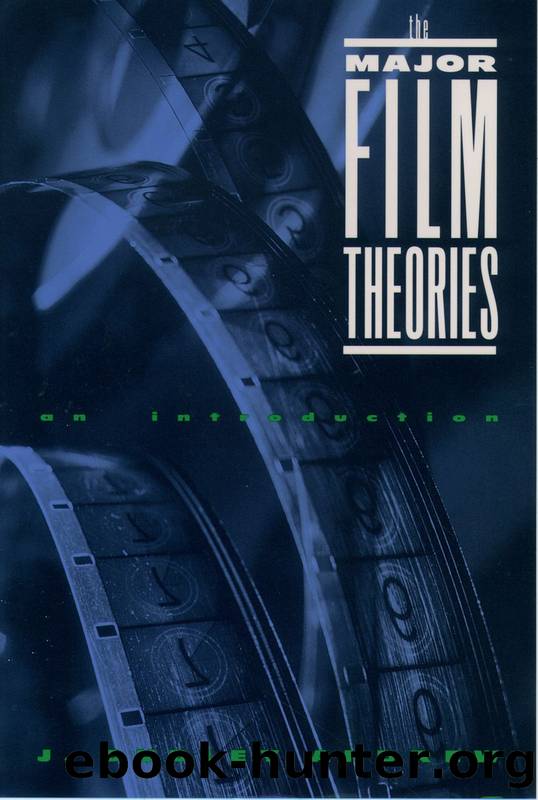Major Film Theories by Andrew J. Dudley;

Author:Andrew, J. Dudley;
Language: eng
Format: epub
Publisher: Oxford University Press, USA
Published: 2011-08-14T16:00:00+00:00
CINEMATIC MEANS AND FORM
Bazin versus Traditional Theory
We have seen that Kracauer, after determining that the raw material filmmakers must shape is reality itself, urged those filmmakers to limit themselves primarily to realistic means in producing films which have a realistic form. This restricting position has annoyed many critics who feel that filmmakers should be allowed to do anything they please with their raw material, even if this material be reality itself.
Hostile critics often attempt to link Bazin with Kracauer because of his lifelong praise of realistic films. Bazin’s belief in the realistic nature of the photographic image led him, to be sure, to a predilection for realistic films but only in these respects : he felt that most films conform to their material rather than against it and that every filmmaker, no matter what his intentions, must take into account the realistic nature of his material, even if he wants to deform or distort that material. Raw material, then, exerts a compelling but not a final influence on the medium. Bazin had a horror of prescriptive aesthetics which dictate what is cinematic from what is not. Always the existentialist, he believed that “cinema’s existence precedes its essence” (What Is Cinema?, p. 71) that theorists must describe and explain what has been done in cinema instead of deducing what should be done from some abstract system.
Bazin’s many remarks on the objectivity of film’s raw material, then, stand to the side of his consideration of the work of the filmmaker. In his abstract jargon, the ontology of cinema stands to the side of the language and function of cinema. It exerts a pull or force on that language but it does not absolutely dictate how cinema is to be used.
Most of Bazin’s writing investigates the style and form of actual works of cinema. He was basically a genre critic, deriving his theories about cinematic means (language) from his meditations on the purpose and shape (form) of films. Bazin perceived a necessary causal link between a film’s form and its means. In practice this came down to a relation between genre and style. For instance, the city symphonies of the twenties (like Berlin or Rien que les heures) were characterized not only by their subject matter, but by rhythmic editing on matched forms, by hide and seek cameras, and by the frequent use of natural dollies like escalators and trollies. In this example even the name of the genre signalled the style which created it. Bazin had an unequalled talent for discerning the genre of a film (its form and the psychological impact of the form) and then discovering the stylistic laws which govern that form and deliver its psychological rewards.
The raw material of cinema, then, is made “to signify” through various cinematic means and it achieves its proper “signification” when it finds its forms. It is up to the theorist to study the various processes (means) by which a filmmaker can make reality (the raw material) significant and, more particularly, to make it significant in a certain humanly valuable way (form).
Download
This site does not store any files on its server. We only index and link to content provided by other sites. Please contact the content providers to delete copyright contents if any and email us, we'll remove relevant links or contents immediately.
The Secret History by Donna Tartt(16627)
The Social Justice Warrior Handbook by Lisa De Pasquale(11489)
Thirteen Reasons Why by Jay Asher(7788)
This Is How You Lose Her by Junot Diaz(5774)
Weapons of Math Destruction by Cathy O'Neil(5038)
Zero to One by Peter Thiel(4824)
The Myth of the Strong Leader by Archie Brown(4789)
Promise Me, Dad by Joe Biden(4449)
Beartown by Fredrik Backman(4420)
Stone's Rules by Roger Stone(4417)
How Democracies Die by Steven Levitsky & Daniel Ziblatt(4399)
The Fire Next Time by James Baldwin(4343)
100 Deadly Skills by Clint Emerson(4079)
A Higher Loyalty: Truth, Lies, and Leadership by James Comey(4033)
Rise and Kill First by Ronen Bergman(4012)
The David Icke Guide to the Global Conspiracy (and how to end it) by David Icke(3883)
The Farm by Tom Rob Smith(3872)
Secrecy World by Jake Bernstein(3783)
The Doomsday Machine by Daniel Ellsberg(3731)
